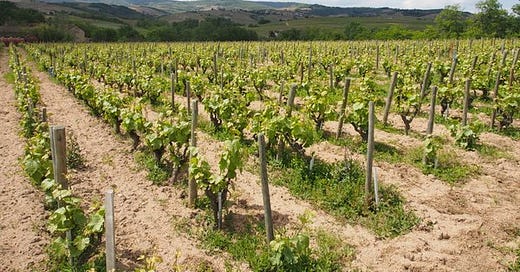Beaujolais stretches south of the Mâconnais, tying Burgundy to the Rhône with a patchwork of granite, schist, and sandy limestone. The grape is Gamay, and the trademark technique is semi-carbonic maceration. This process lifts bright strawberry and violet notes while keeping tannin gentle. From the light, drink-now bottlings of the south to the structured crus on pink granite in the north, Beaujolais offers more range (and value) than its Nouveau reputation suggests.
What You’ll Taste
Primary Notes – Red cherry, wild strawberry, violet, and a hint of banana when carbonic maceration is pushed.
Secondary and Acidity – Black pepper, granite, and medium + acidity.
Tannin – Silky, low tannin in basic bottlings. Fine chalky grip in crus like Morgon or Moulin-à-Vent.
Terroir & Winemaking Deep Dive
Beaujolais divides into two landscapes. In the south, sandstone and clay over limestone give light, fruit-first wines destined for early release. North of Villefranche-sur-Saône the hills steepen - pink granite, blue schist, and crumbly sand support ten named crus. Granite’s low fertility stresses vines, concentrating flavour and mineral tension. Morgon shows dark cherry and iron. Fleurie leans floral and silky. Moulin-à-Vent can age like a light Pinot.
Semi-carbonic maceration dominates. Whole clusters go into cement tanks, CO₂ builds, intracellular fermentation starts, then juice is drawn off for a shorter, traditional ferment. Some cru producers destem and manage traditional Burgundian punch-downs to emphasise depth over bubble-gum fruit. Aging is mainly in concrete or neutral foudres, while a minority use older barriques for gentle oxygenation. The range runs from bistro-ready Beaujolais-Villages to crus that reward five to eight years in bottle.
Producers to Visit
Domaine Marcel Lapierre – Organic Morgon - ripe cherry, silky texture, and fine stony finish.
Château Thivin – Côte de Brouilly shows blackberry, violet, and a firm, granitic core.
Domaine des Terres Dorées – Jean-Paul Brun – L’Ancien old-vine Beaujolais - pure red fruit, minimal carbonic, Burgundian finesse.
Travel Spotlight – Exploring the Beaujolais Hills
Stay – Château de la Chaize (Brouilly) Historic estate turned boutique hotel with sunrise vineyard views.
Dine – Café du Beaujolais (Fleurie) Local charcuterie and coq au vin to match with a chilled cru Fleurie.
Swirl – Sentier des Crêtes Trail Hike the ridge above Morgon and taste while overlooking the patchwork of granite parcels below.
Quiz
How does semi-carbonic maceration create Beaujolais’ signature red-fruit and floral profile while keeping tannin low?
Why do wines from granite-rich crus such as Moulin-à-Vent show more structure and aging potential than basic Beaujolais from the southern sandstone zone?






